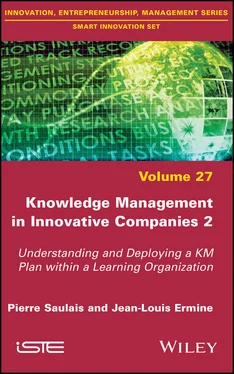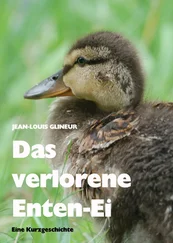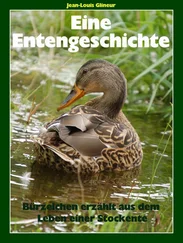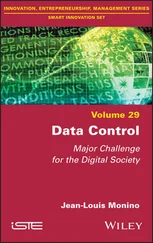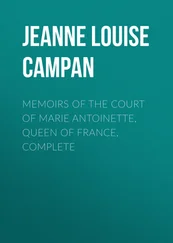1 Cover
2 Preface
3 1 Knowledge Transfer and Knowledge Sharing
1.1. Articulation of Chapter 1 1.2. Introduction to knowledge transfer and sharing
1.3. The case of a banking company
1.4. The Sonatrach case
1.5. The CEFRIO intergenerational knowledge transfer project and the case of Hydro-Québec.
1.6. Case study on choosing a knowledge transfer method
1.7. Case study in agroecology
1.8. Lessons learned from the case studies
4 2 Innovation from the Knowledge Base
2.1. Articulation of Chapter 2 2.2. Introduction to knowledge-based innovation
2.3. The case of ONERA
2.4. The case of an automotive company, PSA Peugeot Citroën
2.5. The case of a defense company
2.6. Introduction to knowledge-based surveillance
2.7. An example for environmental monitoring
2.8. A case of CEA monitoring in the nuclear field
2.9. The case of a Renault monitoring unit
2.10. A methodology for capitalizing on reasoning
2.11. Lessons learned from the case studies
5 3 Case Study of a Global KM Project
3.1. Articulation of Chapter 3 3.2. Introduction
3.3. From awareness to the launch of an ambitious professional activity project
3.4. Operational deployment of the project
3.5. The implementation of the KM plan
3.6. Conclusion – key success factors and perspectives
6 References
7 Index
8 End User License Agreement
1 Chapter 1Table 1.1. Analysis grid for knowledge transfer coded according to [HAR 12]Table 1.2. Formalization of exchanges in order to develop a shared context for t...Table 1.3. Overview of highly critical strategic skillsTable 1.4. Summary table of “business” knowledge areasTable 1.5. Examples of knowledge management actions for a knowledge domainTable 1.6. Examples of knowledge management actions for a strategic competency (...Table 1.7. General structure of our scriptingTable 1.8. Characteristics of each generationTable 1.9. Main behaviorsTable 1.10. Knowledge transfer methodsTable 1.11. Criteria and characteristic areas of their range of variationTable 1.12. Example of an evaluation for classroom training. For a color version...Table 1.13. Case study ratingTable 1.14. Types of interactions to be strengthened between stakeholders in sus...Table 1.15. Hierarchy of critical knowledge in organic agriculture
2 Chapter 1Table 2.1. Knowledge to be explained according to the type of surveillanceTable 2.2. Detailed plan of the different phenomena and concepts modeledTable 2.3. Classes of critical informationTable 2.4. Surveillance requests
1 Chapter 1Figure 1.1. Model of the knowledge transfer processFigure 1.2. Key transfer elementsFigure 1.3. Generational characteristics ([ERM 10])Figure 1.4. Map of strategic competencies in the “Contracts” domain. For a color...Figure 1.5. Map of the business know-how of the “Contracts” DomainFigure 1.6. Knowledge transformation methods within the projectFigure 1.7. Principle of learning content developmentFigure 1.8. General diagram of pedagogical modeling with IMS-LDFigure 1.9. General structure of the scenarioFigure 1.10. Definition of activity steps from MASK modelsFigure 1.11. Definition of learning activities from MASK modelsFigure 1.12. From the knowledge book to educational engineeringFigure 1.13. Rewriting pedagogical educational scenariosFigure 1.14. Rewriting into educational elementsFigure 1.15. Age pyramid at Hydro-QuébecFigure 1.16. Graphical comparative analysis of transfer methods. For a color ver...Figure 1.17. Main actors in knowledge management in direct contact with conventi...Figure 1.18. Role of actors in the knowledge management toolFigure 1.19. Concept model for agricultural machineryFigure 1.20. Weed control task modelFigure 1.21. Organic farming phenomenon model in large-scale farming (Burgundy p...Figure 1.22. Description of a crop successionFigure 1.23. Wheat Technology Route Activity ModelFigure 1.24. Content of the KOFIS knowledge tool in organic field crop agricultu...Figure 1.25. Example of the two spaces [I] and[K]Figure 1.26. KOFIS IT architecture
2 Chapter 2Figure 2.1. The “Innovation Maturity Model” gridFigure 2.2. The innovation procedureFigure 2.3. From the problem to the solutionFigure 2.4. From ideation to innovationFigure 2.5. The model of “chaotic” evolution through the emergence of systemsFigure 2.6. The history model from DRASC to ONERAFigure 2.7. The lineage modelFigure 2.8. Example of an argumentFigure 2.9. Organic model of door framesFigure 2.10. Door frame servicesFigure 2.11. Classification of door framesFigure 2.12. Performance of door frames. For a color version of this figure, see...Figure 2.13. Benefit history. For a color version of this figure, see www.iste.c...Figure 2.14. Example of an antagonism modelFigure 2.15. Use of knowledge capitalization in innovative designFigure 2.16. The funnel model for innovationFigure 2.17. The process of knowledge-based creativity (ICAROS® method)Figure 2.18. Representation in the form of a cognitive map for the “Algorithms” ...Figure 2.19. The process of interaction between knowledge and the environmentFigure 2.20. The projection phase. For a color version of this figure, see www.i...Figure 2.21. The distortion phase. For a color version of this figure, see www.i...Figure 2.22. The identification phase. For a color version of this figure, see w...Figure 2.23. The feedback phase. For a color version of this figure, see www.ist...Figure 2.24. The representation phase. For a color version of this figure, see w...Figure 2.25. The knowledge creation phase. For a color version of this figure, s...Figure 2.26. Generic model of the phenomena to be instrumented. For a color vers...Figure 2.27. Structure of the monitoring domain into three strategic axes for in...Figure 2.28. Projection activity modelFigure 2.29. 2-P parasitic effect of hydrogen consumption by oxygenFigure 2.30. Analogy grouping for pollution abatement technologiesFigure 2.31. Mapping of strategic domains of information researchFigure 2.32. Question askedFigure 2.33. Reasoning of expertsFigure 2.34. Principle and application of a flexible sheathFigure 2.35. Structuring the reasoning base
3 Chapter 3Figure 3.1. The approachFigure 3.2. The knowledge value chainFigure 3.3. The MASK methodFigure 3.4. Adaptation of the global approach to IRSNFigure 3.5. Interactions and contributions of the Sectors and DirectoratesFigure 3.6. Indicators. For a color version of this figure, see www.iste.co.uk/s...Figure 3.7. Capacity analysis against objectivesFigure 3.8. Critical Knowledge AnalysisFigure 3.9. Map of the knowledge repositoryFigure 3.10. A portal for sharing IRSN’s knowledge. For a color version of this ...Figure 3.11. A book from the IRSN collections
1 Cover
2 Table of Contents Table of Contents 1 Cover 2 Preface 3 1 Knowledge Transfer and Knowledge Sharing 1.1. Articulation of Chapter 1 1.2. Introduction to knowledge transfer and sharing 1.3. The case of a banking company 1.4. The Sonatrach case 1.5. The CEFRIO intergenerational knowledge transfer project and the case of Hydro-Québec. 1.6. Case study on choosing a knowledge transfer method 1.7. Case study in agroecology 1.8. Lessons learned from the case studies 4 2 Innovation from the Knowledge Base 2.1. Articulation of Chapter 2 2.2. Introduction to knowledge-based innovation 2.3. The case of ONERA 2.4. The case of an automotive company, PSA Peugeot Citroën 2.5. The case of a defense company 2.6. Introduction to knowledge-based surveillance 2.7. An example for environmental monitoring 2.8. A case of CEA monitoring in the nuclear field 2.9. The case of a Renault monitoring unit 2.10. A methodology for capitalizing on reasoning 2.11. Lessons learned from the case studies 5 3 Case Study of a Global KM Project 3.1. Articulation of Chapter 3 3.2. Introduction 3.3. From awareness to the launch of an ambitious professional activity project 3.4. Operational deployment of the project 3.5. The implementation of the KM plan 3.6. Conclusion – key success factors and perspectives 6 References 7 Index 8 End User License Agreement
Читать дальше
